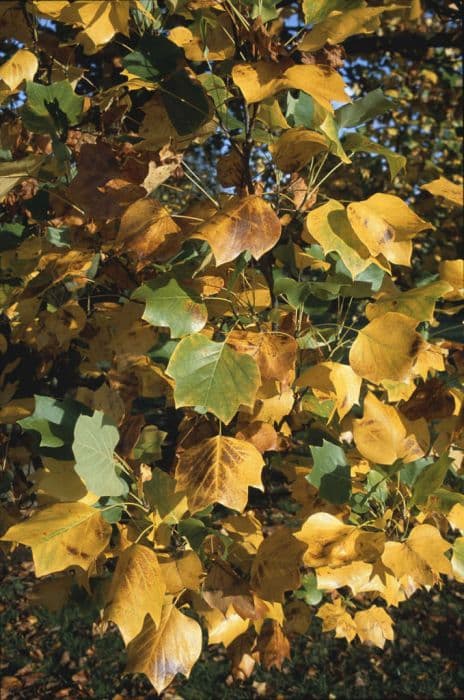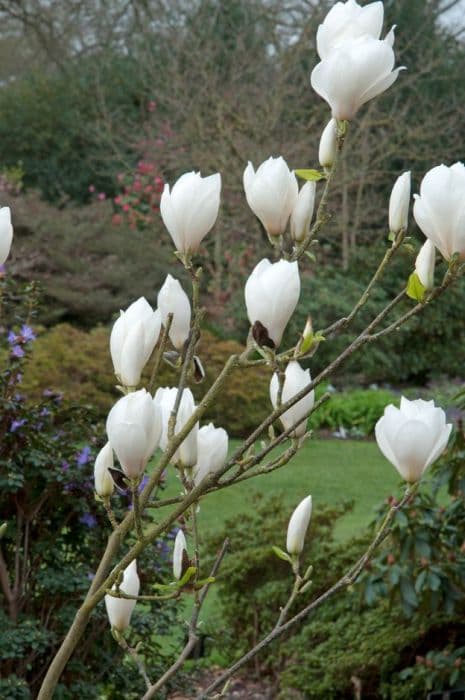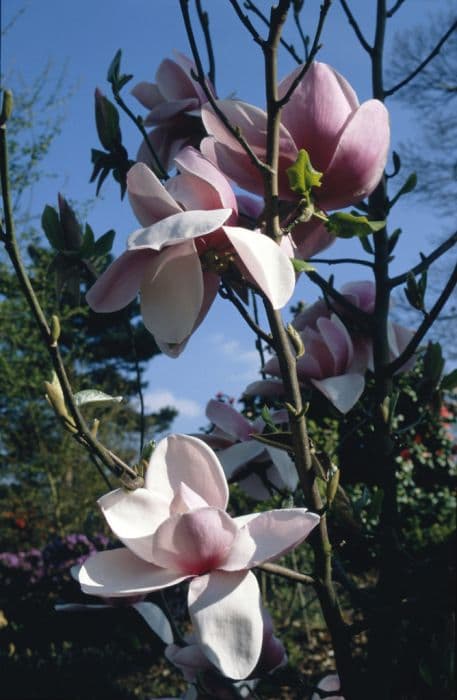Tuliptree Liriodendron tulipifera 'Fastigiatum'

ABOUT
The Tulip Tree 'Fastigiatum' is a captivating deciduous tree known for its distinctive leaf and flower characteristics. The leaves are uniquely shaped, resembling a cat's face or a lyre, with four lobes and a notch at the tip. They are a bright, glossy green, creating a vibrant canopy throughout the growing season. Come fall, these leaves turn to a delightful golden-yellow, offering a striking autumnal display. One of the tree's most notable features is its flowers, which bear a striking resemblance to tulips - hence the name. The flowers are large and attractive, with greenish-yellow petals that have a splash of orange at the base. They usually appear in late spring and early summer, providing a showy spectacle that is also a draw for pollinators such as bees. The bark of the tree is grayish-brown, featuring deep furrows and flat-topped ridges, which provide texture and interest, especially during the winter months when the tree is leafless. Tulip Tree 'Fastigiatum' also has an upright, columnar form, making it notable for its structured, architectural appearance. This vertical growth pattern allows it to impart an elegant presence in the landscape, suitable for various settings where its majestic form can truly be appreciated.
About this plant
 Names
NamesFamily
Magnoliaceae
Synonyms
Upright Tulip Tree, Fastigiate Tuliptree, Columnar Tulip Poplar
Common names
Liriodendron tulipifera.
 Toxicity
ToxicityTo humans
The common name for Liriodendron tulipifera 'Fastigiatum' is Tulip Tree. Tulip trees are generally not considered toxic to humans. There is no widespread evidence or scientific consensus that suggests that the tulip tree causes poisoning when touched or ingested by humans. However, individual allergies and sensitivities can always occur with any plant, so it's wise to approach any plant with caution if you are not certain of how you may react.
To pets
The common name for Liriodendron tulipifera 'Fastigiatum' is Tulip Tree. There is limited information regarding the tulip tree's toxicity to pets, but it is generally not listed as a toxic plant to dogs or cats. However, eating large quantities of any non-edible plant material could potentially cause gastrointestinal upset in pets. If you suspect your pet has eaten a significant amount of tulip tree plant material and is showing symptoms such as vomiting, diarrhea, or changes in behavior, it is advisable to contact a veterinarian.
 Characteristics
CharacteristicsLife cycle
Perennials
Foliage type
Deciduous
Color of leaves
Green
Flower color
Yellow-orange
Height
70 feet (21 meters)
Spread
25 feet (7.6 meters)
Plant type
Tree
Hardiness zones
4-9
Native area
North America
Benefits
 General Benefits
General Benefits- Attractive Foliage: The plant has unique four-lobed green leaves that turn golden yellow in fall, providing seasonal interest.
- Shade Provider: With a tall, spreading canopy, it offers ample shade during hot summer months.
- Wildlife Habitat: Flowers of the tulip tree provide nectar for hummingbirds and other pollinators, while seeds feed birds and small mammals.
- Landscape Design: Its columnar shape makes it an excellent choice for formal gardens or as a focal point in landscape designs.
- Erosion Control: The extensive root system helps stabilize the soil and prevent erosion on slopes or in areas prone to heavy rains.
- Timber Use: The wood is highly valued for its light weight, strength, and versatility in woodworking and furniture making.
 Medical Properties
Medical Properties- This plant is not used for medical purposes.
 Air-purifying Qualities
Air-purifying QualitiesThis plant is not specifically known for air purifying qualities.
 Other Uses
Other Uses- The Tulip Tree's wood can be crafted into musical instruments such as guitars and harps for its resonant qualities.
- Beekeepers sometimes prefer Tulip Trees as a source of nectar for bees to produce a uniquely flavored honey.
- Landscape artists use the tree's unique shape, as 'Fastigiatum' is more columnar, to create visual interest and vertical lines in garden designs.
- The tree's large leaves can be used as a natural mulch to improve soil quality and reduce weed growth.
- Carpenters value Tulip Tree wood for making fine furniture due to its workability and smooth finish.
- Canoe builders historically used the straight trunks of Tulip Trees to carve out large, sturdy canoes for river travel.
- Wood from the tree can be used in the creation of toys and puzzles because it is soft enough to shape yet durable.
- In woodworking, veneers made from Tulip Tree wood are applied to less attractive woods to improve their appearance.
- Artists can use the inner bark of the tree for crafting paper and cardstock, which provides a rustic and natural feel to the finished product.
- As a fast-growing tree, the Tulip Tree can be used for reforestation projects aimed at quick canopy establishment.
Interesting Facts
 Feng Shui
Feng ShuiThe Tuliptree is not used in Feng Shui practice.
 Zodiac Sign Compitability
Zodiac Sign CompitabilityThe Tuliptree is not used in astrology practice.
 Plant Symbolism
Plant Symbolism- Majesty: Liriodendron tulipifera 'Fastigiatum', commonly known as the Tulip Tree, often reaches great heights, symbolizing majesty and tall stature in the natural world.
- Beauty: Its attractive flower-like tulip-shaped leaves and blossoms signify beauty and can be associated with the aesthetic pleasures in life.
- Communication: The tree's association with the Eastern Woodland Native Americans, who used its bark for writing and communication, imparts a symbolic meaning of communication and the spread of knowledge.
- Shelter: The tree’s ability to provide shade and its use historically in building and construction imbue it with the symbolism of shelter and protection.
- Renewal: As a deciduous tree with vibrant seasonal changes, the Tulip Tree symbolizes renewal and the cycle of life.
 Water
WaterFor the Tulip Tree, the watering needs vary by season. During the growing season, it's essential to maintain consistently moist soil, so watering deeply once a week is a standard recommendation, providing approximately 1.5 to 2.5 gallons of water depending on the size and age of the tree. In the absence of rainfall, increase the frequency to twice a week. During the winter months, when the tree is dormant, you can reduce the watering significantly, though it's still important to prevent the soil from completely drying out. Keep in mind that young trees require more frequent watering until they are established.
 Light
LightThe Tulip Tree thrives best in full sun conditions, meaning it requires at least six hours of direct, unfiltered sunlight each day. Planting in a spot that is open to the south or west will ensure that the tree receives ample sunlight, which is vital for its growth and the development of its distinctive flowers. However, it will tolerate light shade but may produce fewer flowers and have a less-robust form.
 Temperature
TemperatureThe Tulip Tree is quite adaptable but prefers temperate climates. It can withstand a maximum temperature of around 100°F in summer and a minimum temperature of about -20°F in winter. The ideal temperature range for this tree's growth and health lies between 60°F and 70°F. Young trees may need additional protection from extreme cold in their first few years.
 Pruning
PruningPruning the Tulip Tree is essential for removing dead or damaged branches, maintaining a desired shape, and promoting vigorous growth. The best time to prune is in the dormant season, late fall or winter, to minimize stress on the tree and reduce the risk of disease. Prune sparingly, as this tree does not require extensive shaping, focusing only on problematic branches. It's generally recommended to prune annually or as needed to remove any problematic growth.
 Cleaning
CleaningAs needed
 Soil
SoilThe Tulip Tree prefers a well-drained, fertile soil with ample organic matter. A mix of loam, compost, and a small amount of sand for drainage would be ideal with a pH ranging from 5.5 to 7.5.
 Repotting
RepottingTulip Trees are typically large and do not lend themselves to frequent repotting. Young trees may be repotted biennially, but mature specimens are better off being top-dressed instead of repotted.
 Humidity & Misting
Humidity & MistingTulip Trees can tolerate a range of humidity levels but prefer average to high humidity, mirroring their native woodland environments.
 Suitable locations
Suitable locationsIndoor
It's a large tree, not suited for indoor growth.
Outdoor
Full sun, moist soil, space to grow; not ideal for small gardens.
Hardiness zone
4-9 USDA
 Life cycle
Life cycleThe life of the Tulip Tree 'Fastigiatum' begins with germination, where its seed sprouts in well-drained soil under the right conditions of warmth and moisture, typically in spring. After the seedling emerges, it enters the juvenile growth phase, developing into a young tree with a more erect and narrow form than the typical Tulip Tree, featuring distinctive lobed leaves and a straight, columnar growth habit. As it matures, the Tulip Tree 'Fastigiatum' enters the reproductive stage, producing unique tulip-like flowers in late spring to early summer, which are yellowish-green with a splash of orange at the base, followed by dry, cone-shaped fruit that disperses seeds. Throughout its life, the tree experiences seasonal growth cycles, with active growth in spring and summer, and dormancy in fall and winter. After many years, potentially exceeding a century, the tree reaches its final stage of life and will eventually succumb to environmental stresses, diseases, or old age, at which point it decomposes and returns nutrients to the soil.
 Propogation
PropogationPropogation time
Spring-Early Summer
The Tulip Poplar 'Fastigiatum' is best propagated by semi-hardwood cuttings taken in late summer. The procedure involves selecting a healthy branch that is not flowering and cutting a 4 to 6-inch (10 to 15 cm) length, making sure there are at least two sets of leaves. The bottom set of leaves is removed, and the cut end is dipped in rooting hormone before being placed in a well-draining potting mix. The cutting should be kept moist and in a warm environment with indirect light until roots develop, which typically takes several weeks. Some growers may also choose to cover the cutting with a plastic bag to retain humidity, but care must be taken to avoid fungal growth. Once rooted, the new Tulip Poplar can be hardened off and eventually transplanted outside.









